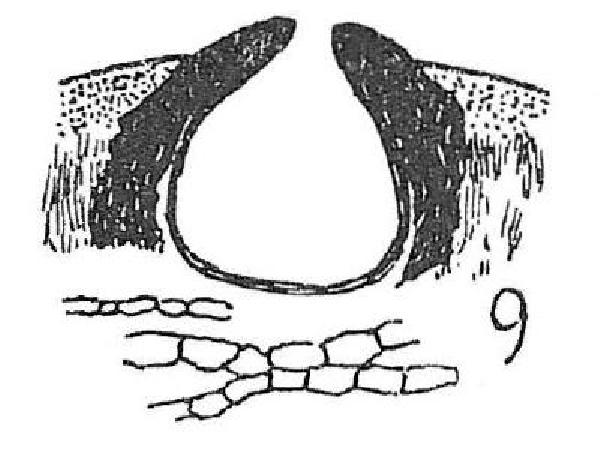Verrucaria cataleptoides (Nyl.) Nyl.
Bull. Soc. Bot. Fr., 10: 268, 1861. Basionym: Verrucaria margacea var. cataleptoides Nyl. - Act. Soc. linn. Bordeaux, 21: 428, 1856.
Synonyms: Verrucaria aethiobola var. cataleptoides (Nyl.) Vain.,
Distribution: N - TAA (Dalla Torre & Sarnthein 1909, Nascimbene & al. 2022).
Description: Thallus crustose, episubstratic, pale grey-brown to pale brown, 0.15-0.23(-0.3) mm thick, not gelatinous when wet, irregularly cracked-areolate, delimited by a discontinuous, black prothallus, the fertile areoles 3-4 times taller and wider than the sterile ones. Cortex 20-30 μm thick; algal layer c. 100 μm thick, continuous, the cells arranged in more or less distinct columns; medulla whitish, c. 100 μm thick, paraplectenchymatous, in lower part often patchily brownish, especially around the perithecia. Perithecia black, immersed in the centre of areoles, 1(-3) per areole. Involucrellum adpressed and completely surrounding the exciple, 50-70(-80) μm thick; exciple 0.2-0.25 μm across, the wall dark brown throughout; hamathecium of up to 40 μm long periphyses and periphysoids, interascal filaments absent. Asci 8-spored, clavate, I-, fissitunicate, the wall thickened above, with an ocular chamber, dehiscent by extrusion of an endotunica to form a delicate rostrum, Verrucaria-type. Ascospores 1-celled, hyaline, ellipsoid, 23-25 x 8-10(-12) μm. Pycnidia black, completely immersed in thallus, 100-150 μm across. Conidia oblong, 6-8 μm long. Photobiont chlorococcoid. Spot tests: K-, C-, KC-, P-, UV-. Chemistry: without lichen substances.
Note: on periodically submerged calcareous rocks. According to Breuss (2008b) this species, frequently considered as a synonym of V. aethiobola, clearly differs in important morphological characters and in the occurrence on calcareous rocks (like the sample collected in South Tyrol near Arco by Kernstock, see Dalla Torre & Sarnthein 1909: 517). The Italian record, however, needs confirmation.
Growth form: Crustose
Substrata: rocks
Photobiont: green algae other than Trentepohlia
Reproductive strategy: mainly sexual
Poorly known taxon in need of further study
Commonnes-rarity: (info)
Alpine belt: absent
Subalpine belt: extremely rare
Oromediterranean belt: absent
Montane belt: extremely rare
Submediterranean belt: extremely rare
Padanian area: absent
Humid submediterranean belt: absent
Humid mediterranean belt: absent
Dry mediterranean belt: absent

Predictive model
Growth form: Crustose
Substrata: rocks
Photobiont: green algae other than Trentepohlia
Reproductive strategy: mainly sexual
Poorly known taxon in need of further study
Commonnes-rarity: (info)
Alpine belt: absent
Subalpine belt: extremely rare
Oromediterranean belt: absent
Montane belt: extremely rare
Submediterranean belt: extremely rare
Padanian area: absent
Humid submediterranean belt: absent
Humid mediterranean belt: absent
Dry mediterranean belt: absent

Predictive model
 INDEX FUNGORUM
INDEX FUNGORUM
 GBIF
GBIF
 DOLICHENS
DOLICHENS



